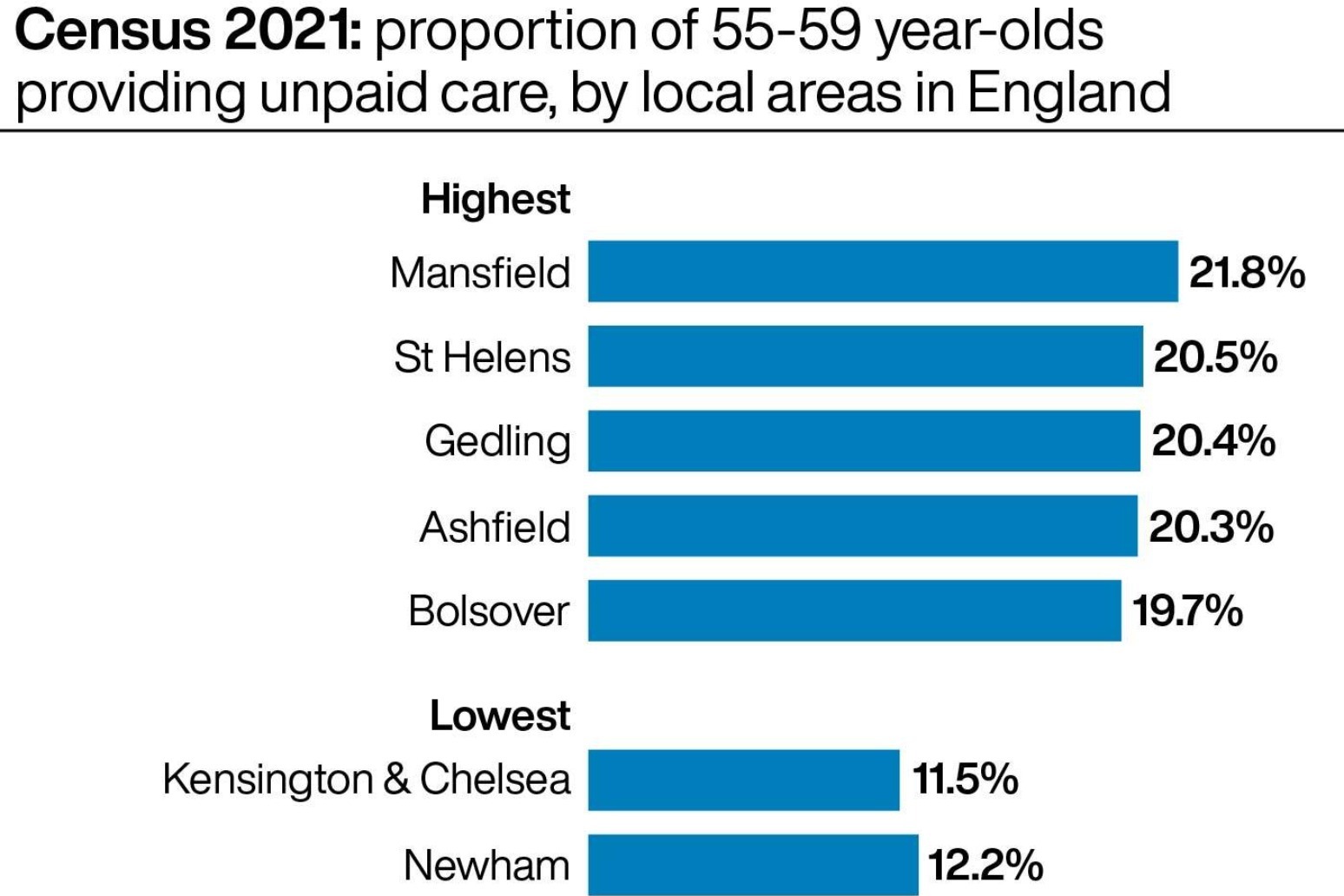
One in five 55- 59 year olds in parts of England are unpaid carers
The proportion rises to as high as one in four in a few places when looking only at female unpaid carers.
Around one in five 55 to 59-year-olds in some areas of England spend part of their time providing unpaid care, census data shows.
The proportion rises to as high as one in four in a few places when looking only at female unpaid carers.
There is also evidence of a broad geographical divide, as those areas with the highest levels of unpaid care are mostly in north-west England and the Midlands, while those with the lowest are overwhelmingly in London and the South East.
The figures have been released by the Office for National Statistics (ONS) in the latest batch of data from the census, which took place in England and Wales on March 21 2021.
The census asked people to indicate if they look after, or give any help or support to, anyone because they have “long-term physical or mental health conditions or illnesses, or problems related to old age”.
People were asked to exclude anything they did as part of their paid employment.
Initial results published last month showed there were approximately 4.7 million unpaid carers in England and 310,000 in Wales at the time of the census, the equivalent of 8.9% and 10.5% of the usual resident population aged five and over.
The new data provides details of unpaid carers by age and sex in both regional and local areas.
It shows that in every region of England, the proportion of people doing unpaid care is highest in the 55 to 59-year-old age group, ranging from 17.9% in north-east England to 14.1% in London.
The differences are much sharper at local level, however.
Some areas of England have around one in five 55 to 59-year-olds likely to be providing unpaid care, with the highest proportion in Mansfield in Nottinghamshire (21.8%), followed by St Helens in Merseyside (20.5%), Gedling in Nottinghamshire (20.4%), Ashfield in Nottinghamshire (20.3%) and Bolsover in Derbyshire (19.7%).
The lowest proportions are all in London, starting with Kensington & Chelsea (11.5%), then Newham (12.2%), City of London & Westminster (12.3%), Southwark (12.4%) and Hammersmith & Fulham (12.6%).
There is a similar trend among the 60-64 age group, with areas of the East Midlands again dominating the highest rankings: Ashfield (20.8%), Gedling (19.8%), Mansfield (19.4%), Broxtowe in Nottinghamshire (19.1%) and Blaby in Leicestershire (18.9%).
All but one of the bottom five for this age group are in London, with Lambeth the lowest at 11.9%, followed by Kensington & Chelsea (11.9%), Slough in Berkshire (12.0%), Hammersmith & Fulham (12.2%) and City of London & Westminster (12.2%).
When looking solely at female unpaid carers, around a quarter of 55 to 59-year-olds in Mansfield are likely to provide unpaid care (25.2%), with similarly high levels in Gedling (24.5%) and St Helens (24.3%).
The equivalent figures for 55 to 59-year-old males are 18.1% in Mansfield, 16.0% in Gedling and 16.7% in St Helens.
Areas in north-west England tend to have the highest proportion of unpaid carers among younger age groups, while the East Midlands has the highest among many of the older age groups.
Halton in Cheshire tops the list for five to 17-year-olds (2.7%) as well as people aged 25-29 (8.4%) and 30-34 (10.3%), while Knowsley in Merseyside is top for people aged 18-24 (8.2%), 40-44 (13.9%) and 45-49 (16.8%).
By contrast, Mansfield has the highest proportion of unpaid carers among people aged 50-54 (19.7%) and 55-59 (21.8%), Ashfield is top for people aged 60-64 (20.8%) and 65-69 (15.3%), and Bolsover is top for those aged 70-74 (14.1%) and 75-79 (13.1%).
Tendring in Essex has the highest proportion for 35-39 year-olds (12.1%), Amber Valley in Derbyshire has the highest for 80 to 84-year-olds (12.6%), Brentwood in Essex is highest for 85 to 89-year-olds (10.8%) and Rutland in the East Midlands is highest for people aged 90 and over (8.5%).
The census was completed by more than 24 million households across England and Wales on March 21 2021.
It takes place across the UK every 10 years and provides the most accurate estimate of all the people and households in the country.
